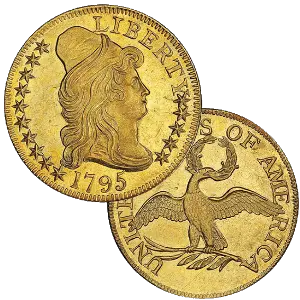The $5 gold coin, also known as the Half Eagle, holds a significant place in United States numismatic history. Here's a brief overview of its evolution from 1795 to 2024:
The first $5 gold coin was minted in 1795, featuring a bust of Liberty facing right on the obverse and an eagle on the reverse. Designs and variations changed over time, with different renditions of Liberty and various eagle motifs. During this period, the coin underwent modifications in weight and fineness due to fluctuations in the price of gold.
The Capped Bust design was introduced in 1807 and is a fascinating piece of American numismatic history. The Capped Bust motif, designed by John Reich, graces the 1807 half eagle. On the obverse, a buxom Miss Liberty faces left, adorned with a cloth cap inscribed “LIBERTY.” Her curly hair flows from the cap down to her shoulder. The reverse features an eagle with outstretched wings, clutching an olive branch and arrows. The denomination “5 D.” (for $5) appears below the eagle. The Capped Bust $5 gold coins were minted during a period of significant change in American history. These coins circulated during the early 19th century, witnessing events like the War of 1812 and the expansion of the United States.
In 1834, the Classic Head designed by William Kneass was introduced, featuring Liberty wearing a headband inscribed with "Liberty." On the reverse, you’ll find an eagle with outstretched wings, standing on a bundle of arrows and an olive branch. The weight and fineness of gold in these coins were standardized during this period.
The Liberty Head design, commonly referred to as the Coronet Head, was introduced in 1839 and continued until 1908. Designed by Christian Gobrecht, these coins featured a left-facing Liberty wearing a coronet inscribed with “Liberty.” Variations included changes to the diameter and minor modifications to the design over the years.
The Indian Head design, also known as the Indian Head Eagle, was introduced in 1908. Designed by Augustus Saint-Gaudens, the obverse featured a Native American chief in a full headdress, while the reverse depicted a standing eagle. This design is often regarded as one of the most beautiful in American coinage history. Production ceased in 1929 due to the economic turmoil of the Great Depression.
In 1986, the United States Mint began issuing modern commemorative $5 gold coins as part of various programs, honoring historical events, figures, and institutions. These modern commemoratives often feature unique designs on both the obverse and reverse, celebrating themes ranging from the Olympics to national parks and historic anniversaries. Throughout its history, the $5 gold coin has seen changes in design, composition, and purpose. While no longer circulated for general use, these coins hold significant value to collectors and investors alike, both for their historical importance and intrinsic worth.

